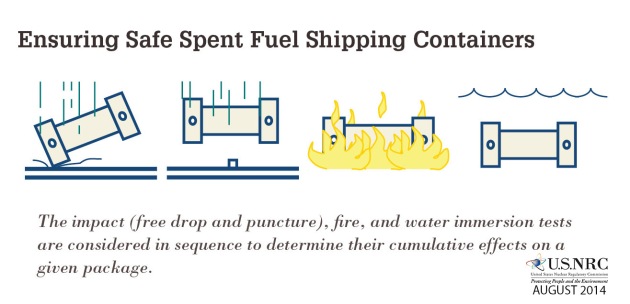Testing Spent Fuel Transport Casks Using Scale Models
Posted by on June 18, 2015
Senior Project Manager
Division of Spent Fuel Storage and Transportation
Before casks can be used to transport the most radioactive cargo—including spent nuclear fuel—the NRC requires them to undergo a thorough safety evaluation. Casks are evaluated for their ability to withstand vibration, water spray, free fall, stacking, penetration and fire. A cask must be able to contain and shield the spent fuel and keep it in a safe configuration under both normal and accident conditions. Typically, spent fuel casks are certified through a combination of engineering analyses and scale model or component testing.
People often ask why the NRC allows designers to test scale models instead of requiring tests on full-sized casks. The bottom line is scale-model testing provides the necessary information for the NRC staff to know that a cask loaded with spent fuel can be transported safely, even in the event of an accident.
 First,
it is important to understand what information comes out of these
tests. Test casks are fitted with sensors to measure acceleration. These
accelerometers are similar to the ones used in smart phones, video game
remotes and pedometers to respond to the movements of the user. Knowing
the cask’s acceleration allows designers and the NRC to understand the
forces different parts of the cask will experience in different types of
impacts. The design engineer generally calculates these impact forces
first by hand or by computer. Tests on a scale model can be used to
check the accuracy of these analyses.
First,
it is important to understand what information comes out of these
tests. Test casks are fitted with sensors to measure acceleration. These
accelerometers are similar to the ones used in smart phones, video game
remotes and pedometers to respond to the movements of the user. Knowing
the cask’s acceleration allows designers and the NRC to understand the
forces different parts of the cask will experience in different types of
impacts. The design engineer generally calculates these impact forces
first by hand or by computer. Tests on a scale model can be used to
check the accuracy of these analyses.Engineers follow a similar process to safety-test airplanes, ships, bridges, buildings and other large structures. Scale-model testing is a proven and accepted practice across engineering disciplines, and may be one of the oldest engineering design tools. (Ancient Egyptian, Greek, and Roman builders are known to have built small models to assist in planning structures.) Today, models allow oversized structures to be examined in wind tunnels, under different weight loads and on shake tables to provide key inputs into design and safety reviews.
Cost savings is a factor, but not the most important one. The biggest reason for using scale models is practicality. Transport casks for spent nuclear fuel are typically in the 25-ton to 125-ton range. There are very few testing facilities in the world that can put a 125-ton cask through the required tests.
For example, during 30-foot drop test, the test cask must strike the surface in the position that would cause the most severe damage. Cask designers often perform several drops to ensure they identify the correct position. After the 30-foot drop, the cask is dropped 40 inches onto a cylindrical puncture bar, then placed in a fully-engulfing fire for 30 minutes. Casks are also immersed in water to ensure they don’t leak. Measurements from these tests are plugged into computer programs that analyze the cask structure in great detail.
This analysis can determine the stresses placed on cask closure bolts, canisters and baskets that hold the spent fuel in place, and the spent fuel assemblies themselves. Computer simulations can be run for different scenarios, providing maximum flexibility to designers in understanding how best to design different parts of a cask’s structure.
In addition, NRC regulations specify that in the 30-foot drop test, the cask must hit an “unyielding” surface. This means the cask itself, which may be fitted with “impact limiters,” has to absorb all the damage. The impact limiters work much like the bumper that protects a car in a collision. The target surface cannot dent, crack or break in any way. In a real-world accident, a 125-ton cask would damage any surface significantly. It requires considerably more engineering work to achieve an unyielding surface for a full-sized cask than for a scale model, with no measurable advantage. The rule-of-thumb for testing is the impact target should be 10 times the mass of the object that will strike it. So a 125-ton cask would need to hit a 1,250 ton surface. A 30-ton cask would only need a 300-ton target.
Scale models are easier to handle and can be used efficiently for many drop orientations to meet the multiple test requirements. If a test needs to be run again, it can be done much more easily with a scale model. Design changes are also more easily tested on models. Together with extensive analyses of a cask’s ability to meet our regulatory requirements, the information from these tests allows the NRC to decide whether a cask can safely transport the radioactive contents.

No comments:
Post a Comment